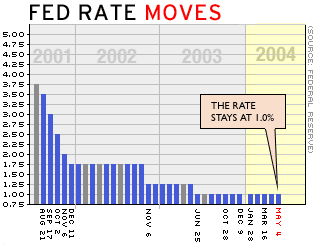NEW YORK (CNN/Money) -
Federal Reserve policy-makers held a key interest rate at the lowest level in more than 40 years Tuesday, but dropped a long-held pledge to be "patient" before raising rates, setting the stage for future increases.
The central bankers left their target for the federal funds rate at 1 percent, a level last touched in 1962 and not seen on a consistent basis since 1958. The fed funds rate is an overnight bank loan rate that influences many banks' prime lending rates, and most economists expect the Fed to raise it some time this year.
In the closely watched statement accompanying its unanimous decision, the Fed altered its stance on its highly accommodative policy, saying "accommodation can be removed at a pace that is likely to be measured," a subtle shift from its previous promise to be "patient."
"This is a further advancement of the date at which the Fed starts to raise rates," said David Kelly, senior economist at Putnam Investments. "I think this puts the odds of a rate increase at their June 29-30 meeting at about 50 percent." (For more on the bets traders are making in the futures markets about a rate hike, click here.)
| 
| |

| 
| 
|

|
 Federal Reserve policy-makers leave interest rates unchanged. Federal Reserve policy-makers leave interest rates unchanged.
|
 Play video
Play video
(Real or Windows Media)
|
| 
|

|
|
The change was inspired by recent data showing stronger inflation, which led central bankers to declare that the risks of rising prices and falling prices -- or "deflation," which was something of a worry last year -- were balanced.
At the Fed's policy meeting in March, the Fed said the risks were "almost equal," but tilted slightly in favor of falling prices.
In its latest statement, the Fed said that, while data had shown an increase in prices, inflation expectations seemed to be "contained." In the statement accompanying its decision in March, it had said price increases were "muted and expected to remain low."
The Fed's view of the job market also improved slightly. It said "hiring appears to have picked up," while in March it said hiring was lagging.

Otherwise, however, the Fed's statement was little changed. Some market participants had expected the Fed to be more "hawkish," to show a little more alarm about inflation, which might lead them to be more aggressive in raising rates.
Their slightly more "dovish" stance helped boost stock and bond prices at first. But near the close of trading, worries about the inevitability of higher rates seemed to gain the upper hand, leaving stock prices little changed, while bond prices ended their trading day lower, sending yields, which move in the opposite direction, higher.
Though many analysts believe stock prices can rise despite higher interest rates, some investors still remember 1994, when the Fed raised rates aggressively and hurt stocks.
| Related stories
|

|
|
|
|
"What the Fed is trying to say is, 'We're getting ready to tighten, but it won't be a rerun of 1994,'" said Paul Kasriel, director of economic research at Northern Trust. "Of course, they don't know that -- they didn't think 1994 was going to be the way it was."
The Fed lowers its fed funds target when it wants to encourage borrowing and stimulate the economy. It raises the target when it wants to tap the economy's brakes and fend off inflation.
The Fed cut rates repeatedly in 2001, fighting a recession and terror attacks, and added one cut a year in 2002 and 2003 when the economy was still not as robust as policy-makers had hoped.
Some economists, seeing a falling dollar, rising commodity prices and sudden improvement in job market data, had grown worried that rates were too low and that the Fed might be forced to move quickly to fight inflation.
But some Fed policy-makers have indicated in recent speeches that, with unemployment higher than it could be, job growth still not fully recovered from the recession, and much factory equipment still sitting idle, inflation will stay in check. The accuracy of this view will determine the speed at which rates rise.
"The rate increases will start off slowly, but if inflation keeps accelerating, all bets are off afterward," said Joel Naroff, president of Naroff Economic Advisors.
One hint about the amount of "slack" still in the economy will come on Friday, when the Labor Department reports on unemployment and job growth in April. Economists, on average, expect unemployment to hold steady and non-farm payrolls to grow by 175,000 jobs, according to Briefing.com.
A stronger report will raise expectations for a June rate hike, while a weaker report could delay the first Fed tightening.

|